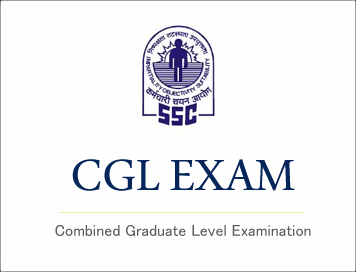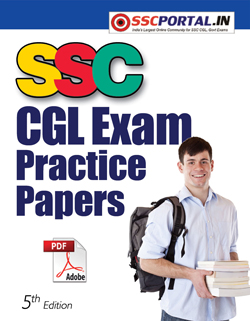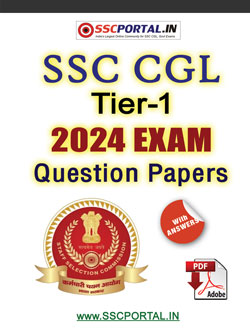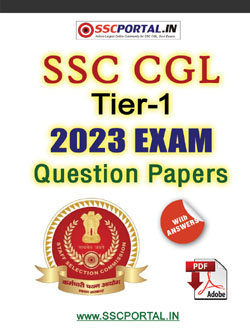NEW! SSC CGL PDF NOTES
SSC CGL (Tier - 1) Online Exam Paper - 2016 "held on 4 September 2016" Morning Shift (English Comprehension)

SSC CGL (Tier - 1) Online Exam Paper - 2016 "held on 4 September 2016" Morning Shift (English Comprehension)
EXAM DATE : - 4 September-2016
EXAM START TIME : 10:00:00
EXAM NAME : SSC Examination 2016
Question 76.In the following question, out of the four alternatives, choose the word which best expresses the meaning of the given word and click the button corresponding to it.
EXAGGERATE
Options:
1) MAGNIFY
2) IMAGINE
3) REINFORCE
4) REITERATE
Correct Answer: MAGNIFY
Question 77.In the following question, out of the four alternatives, choose the word which is opposite in meaning to the given word and click the button corresponding to it.
GREGARIOUS
Options:
1) UNSOCIABLE
2) UNSYMPATHETIC
3) UNGRATEFUL
4) UNATTRACTIVE
Correct Answer: UNSOCIABLE
Question 78.Four words are given, out of which only one word is spelt correctly. Choose the correctly spelt word and click the button corresponding to it.
Options:
1) Serendipty
2) Serendipity
3) Serndipity
4) Sernidipity
Correct Answer: Serendipity
Question 79.In the following questions, one part of the sentence may have an error. Find out which part of the sentence has an error and click the button corresponding to it. If the sentence is free from error, click the "No error" option.
Considering the (A) / gravity of the problems (B) / an early reply has expected (C) / No Error (D)
Options:
1) A
2) B
3) C
4) D
Correct Answer: C
Question 80.In the following questions, one part of the sentence may have an error. Find out which part of the sentence has an error and click the button corresponding to it. If the sentence is free from error, click the "No error" option.
The Statesman has the (A) / larger circulation (B) / of all English dailies (C) / No Error (D)
Options:
1) A
2) B
3) C
4) D
Correct Answer: B
Question 81.In the following questions, one part of the sentence may have an error. Find out which part of the sentence has an error and click the button corresponding to it. If the sentence is free from error, click the "No error" option.
I am very anxious (A) / to know how are you (B) / and mother are doing (C) / No Error (D)
Options:
1) A
2) B
3) C
4) D
Correct Answer: B
Question 82.The sentences given with blanks are to be filled with an appropriate word(s). Four alternatives are suggested for each question. For each question, choose the correct alternative and click the button corresponding to it.
Everything _____ carefully checked.
Options:
1) has been
2) have been
3) are being
4) is been
Correct Answer: has been
Question 83.The sentences given with blanks are to be filled with an appropriate word(s). Four alternatives are suggested for each question. For each question, choose the correct alternative and click the button corresponding to it.
I've _____ finished painting the house.
Options:
1) about
2) nearing
3) towards
4) almost
Correct Answer: almost
Question 84.The sentences given with blanks are to be filled with an appropriate word(s). Four alternatives are suggested for each question. For each question, choose the correct alternative and click the button corresponding to it.
She _____ made him angry.
Options:
1) have absolutely
2) has certainly
3) have certainly
4) has absolutely
Correct Answer: has certainly
Question 85.In each of the questions, four alternatives are given for the Idiom/Phrase. Choose the alternative which best expresses the meaning of the Idiom/Phrase and click the button corresponding to it.
Burn your boats
Options:
1) Have a burning desire to win
2) Become extremely tired after working very hard
3) Do something that makes it impossible to return to the previous situation
4) Want to spend money as soon as you get it
Correct Answer: Do something that makes it impossible to return to the previous situation
Question 86.In each of the questions, four alternatives are given for the Idiom/Phrase. Choose the alternative which best expresses the meaning of the Idiom/Phrase and click the button corresponding to it.
Dressing-down
Options:
1) Apply bandage
2) Wear an expensive gown
3) Give a scolding
4) Pretend
Correct Answer: Give a scolding
(E-Book) SSC CGL (Tier-1) Exam Question Papers PDF with Ans Download
Click Here To Download Full PDF
DOWNLOAD SSC CGL (Tier-1) 2020 SOLVED Question Papers PDF (ENGLISH)
DOWNLOAD SSC CGL, CHSL, JE E-Books PDF
एसएससी - कर्मचारी चयन आयोग (सीजीएल) परीक्षा अध्ययन सामग्री
Study Kit for SSC CGL EXAM (English)
Question 87.In each of the questions, four alternatives are given for the Idiom/Phrase. Choose the alternative which best expresses the meaning of the Idiom/Phrase and click the button corresponding to it.Null and void
Options:
1) Invalid
2) Observant
3) Uncontrolled
4) Homeless
Correct Answer: Invalid
Question 88.Out of the four alternatives, choose the one which can be substituted for the given words/sentences and click the button corresponding to it.
Write or carve words on stone or paper
Options:
1) Sketch
2) Imprint
3) Affix
4) Inscribe
Correct Answer: Inscribe
Question 89.Out of the four alternatives, choose the one which can be substituted for the given words/sentences and click the button corresponding to it.
Unable to pay one's debt
Options:
1) Insolvent
2) Impute
3) Indebt
4) Obligate
Correct Answer: Insolvent
Question 90.Out of the four alternatives, choose the one which can be substituted for the given words/sentences and click the button corresponding to it.
Trouble and annoy continually
Options:
1) Complaint
2) Harass
3) Punish
4) Oppress
Correct Answer: Harass
Question 91.A sentence/a part of the sentence is underlined. Four alternatives are given to the underlined part which will improve the sentence. Choose the correct alternative and click the button corresponding to it. In case no improvement is needed, click the button corresponding to "No improvement".
The Chairman's harsh words like insult to injury to the embarrassed speaker.
Options:
1) added
2) evoked
3) invoked
4) No improvement
Correct Answer: added
Question 92.A sentence/a part of the sentence is underlined. Four alternatives are given to the underlined part which will improve the sentence. Choose the correct alternative and click the button corresponding to it. In case no improvement is needed, click the button corresponding to "No improvement".
He is in of sorts today.
Options:
1) out
2) on
3) outside
4) No improvement
Correct Answer: out
Question 93.A sentence/a part of the sentence is underlined. Four alternatives are given to the underlined part which will improve the sentence. Choose the correct alternative and click the button corresponding to it. In case no improvement is needed, click the button corresponding to "No improvement".
She told to me the news.
Options:
1) said me
2) said to me
3) told me
4) No improvement
Correct Answer: told me
Question 94.A sentence/a part of the sentence is underlined. Four alternatives are given to the underlined part which will improve the sentence. Choose the correct alternative and click the button corresponding to it. In case no improvement is needed, click the button corresponding to "No improvement".
The philanthropist bestowed a lakh to the orphanage.
Options:
1) granted
2) parted with
3) donated
4) No improvement
Correct Answer: donated
Question 95.A sentence/a part of the sentence is underlined. Four alternatives are given to the underlined part which will improve the sentence. Choose the correct alternative and click the button corresponding to it. In case no improvement is needed, click the button corresponding to "No improvement".
There are a better ways of solving the problem.
Options:
1) There are different ways of solving a problem.
2) There is a better way of looking at the problem.
3) There are better ways of solving the problem.
4) No improvement
Correct Answer: There are better ways of solving the problem.
Question 96.A passage is given with 5 questions following it. Read the passage carefully and choose the best answer to each question out of the four alternatives and click the button corresponding to it.
In general it is better to use too little make-up than too much. The audience should not be aware that the actor's face is painted. For the actor who is playing his own age, the artist uses make-up to strengthen the features, particularly eyes and mouth, and to add lifelike colour to the face. Character make-up does these things in addition to transforming the face to another age, another type or another race. This transformation, particularly for young actors playing old characters, can be helped greatly by hats and hairdos.
Make-up consists of applying a base colour, then modelling the face by highlighting and shadowing (sinking the cheeks, for example, with a darker colour). Sometimes, modelling is done by applying false (putty or plastic) noses, enlarged eyebrows, or scars. Lines to suggest wrinkles are drawn on with a dark make-up pencil (brown or maroon, not black) or brush. Each line is highlighted with another line, either white or a light tint of the base colour. Lips are outlined and coloured, and a similar colour is applied to the cheeks. After make-up is complete, powder is applied.
The artist uses make-up to strengthen the features, particularly eyes and mouth, and to add life like colours to the face for the actor who is playing _____ .
Options:
1) the lead role
2) the old man or woman
3) his own age
4) the role of the clown
Question 97.A passage is given with 5 questions following it. Read the passage carefully and choose the best answer to each question out of the four alternatives and click the button corresponding to it.
In general it is better to use too little make-up than too much. The audience should not be aware that the actor's face is painted. For the actor who is playing his own age, the artist uses make-up to strengthen the features, particularly eyes and mouth, and to add lifelike colour to the face. Character make-up does these things in addition to transforming the face to another age, another type or another race. This transformation, particularly for young actors playing old characters, can be helped greatly by hats and hairdos.
Make-up consists of applying a base colour, then modelling the face by highlighting and shadowing (sinking the cheeks, for example, with a darker colour). Sometimes, modelling is done by applying false (putty or plastic) noses, enlarged eyebrows, or scars. Lines to suggest wrinkles are drawn on with a dark make-up pencil (brown or maroon, not black) or brush. Each line is highlighted with another line, either white or a light tint of the base colour. Lips are outlined and coloured, and a similar colour is applied to the cheeks. After make-up is complete, powder is applied.
What do artists use to help young actors playing old men?
Options:
1) Wig and moustache
2) Hats and hairdos
3) Wheel chairs and walking sticks
4) False noses, enlarged eyebrows or scars
Correct Answer: Hats and hairdos
Question 98.A passage is given with 5 questions following it. Read the passage carefully and choose the best answer to each question out of the four alternatives and click the button corresponding to it.
In general it is better to use too little make-up than too much. The audience should not be aware that the actor's face is painted. For the actor who is playing his own age, the artist uses make-up to strengthen the features, particularly eyes and mouth, and to add lifelike colour to the face. Character make-up does these things in addition to transforming the face to another age, another type or another race. This transformation, particularly for young actors playing old characters, can be helped greatly by hats and hairdos.
Make-up consists of applying a base colour, then modelling the face by highlighting and shadowing (sinking the cheeks, for example, with a darker colour). Sometimes, modelling is done by applying false (putty or plastic) noses, enlarged eyebrows, or scars. Lines to suggest wrinkles are drawn on with a dark make-up pencil (brown or maroon, not black) or brush. Each line is highlighted with another line, either white or a light tint of the base colour. Lips are outlined and coloured, and a similar colour is applied to the cheeks. After make-up is complete, powder is applied.
What is the correct sequence for make-up?
Options:
1) Modelling the face by highlighting and shadowing then applying a base colour
2) Highlighting and shadowing, then applying a base colour and modelling the face
3) Applying a base colour, then modelling the face by highlighting and shadowing
4) Shadowing and modelling, then applying a base colour for highlighting
Correct Answer: Applying a base colour, then modelling the face by highlighting and shadowing
Question 99.A passage is given with 5 questions following it. Read the passage carefully and choose the best answer to each question out of the four alternatives and click the button corresponding to it.
In general it is better to use too little make-up than too much. The audience should not be aware that the actor's face is painted. For the actor who is playing his own age, the artist uses make-up to strengthen the features, particularly eyes and mouth, and to add lifelike colour to the face. Character make-up does these things in addition to transforming the face to another age, another type or another race. This transformation, particularly for young actors playing old characters, can be helped greatly by hats and hairdos.
Make-up consists of applying a base colour, then modelling the face by highlighting and shadowing (sinking the cheeks, for example, with a darker colour). Sometimes, modelling is done by applying false (putty or plastic) noses, enlarged eyebrows, or scars. Lines to suggest wrinkles are drawn on with a dark make-up pencil (brown or maroon, not black) or brush. Each line is highlighted with another line, either white or a light tint of the base colour. Lips are outlined and coloured, and a similar colour is applied to the cheeks. After make-up is complete, powder is applied.
Lines are drawn with a dark make-up pencil or brush to suggest _____ .
Options:
1) dimples
2) wrinkles
3) smiles
4) pimples
Correct Answer: wrinkles
Question 100.A passage is given with 5 questions following it. Read the passage carefully and choose the best answer to each question out of the four alternatives and click the button corresponding to it.
In general it is better to use too little make-up than too much. The audience should not be aware that the actor's face is painted. For the actor who is playing his own age, the artist uses make-up to strengthen the features, particularly eyes and mouth, and to add lifelike colour to the face. Character make-up does these things in addition to transforming the face to another age, another type or another race. This transformation, particularly for young actors playing old characters, can be helped greatly by hats and hairdos.
Make-up consists of applying a base colour, then modelling the face by highlighting and shadowing (sinking the cheeks, for example, with a darker colour). Sometimes, modelling is done by applying false (putty or plastic) noses, enlarged eyebrows, or scars. Lines to suggest wrinkles are drawn on with a dark make-up pencil (brown or maroon, not black) or brush. Each line is highlighted with another line, either white or a light tint of the base colour. Lips are outlined and coloured, and a similar colour is applied to the cheeks. After make-up is complete, powder is applied.
When is powder usually applied?
Options:
1) Before the make-up
2) As make-up foundation
3) After the make-up
4) During the make-up
Correct Answer: After the make-up







